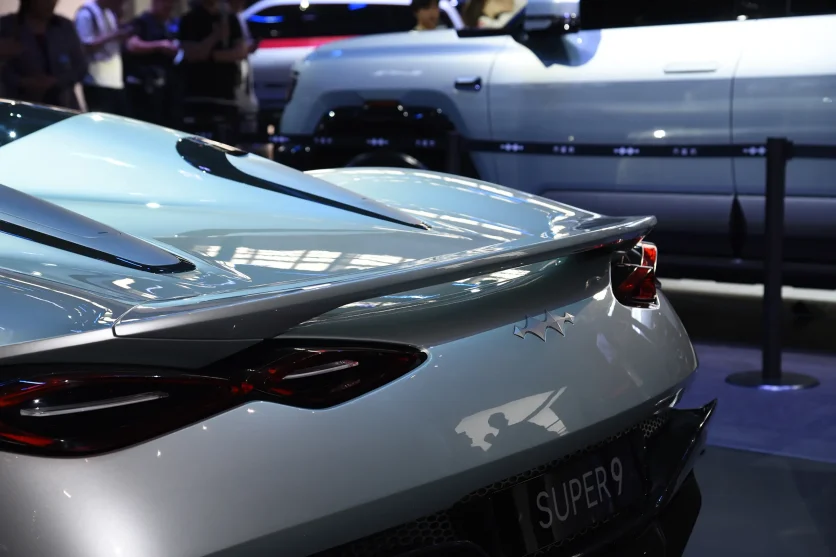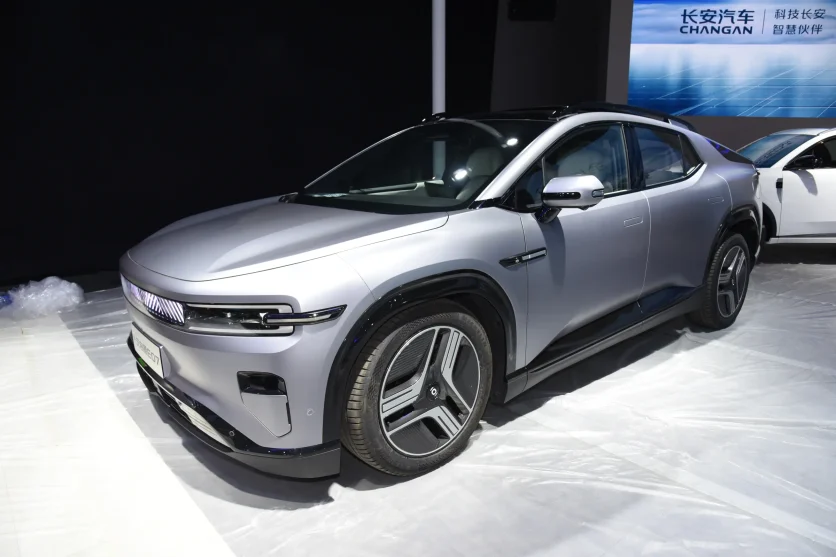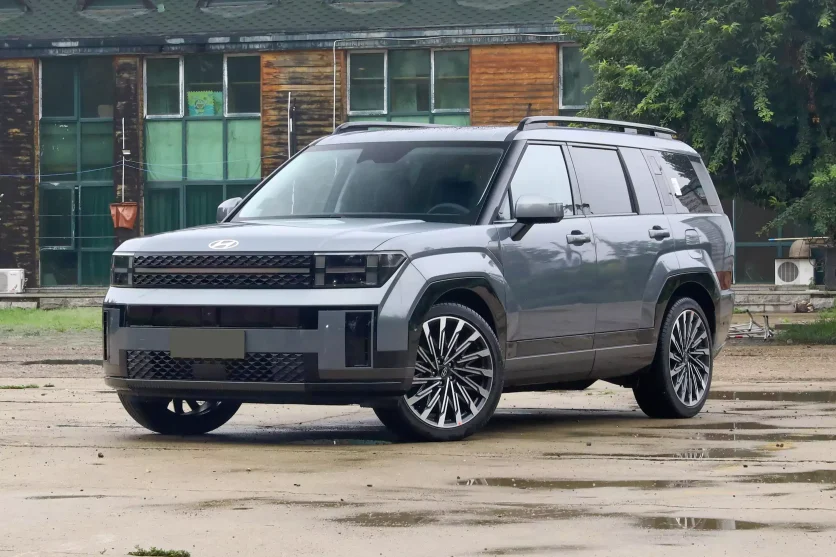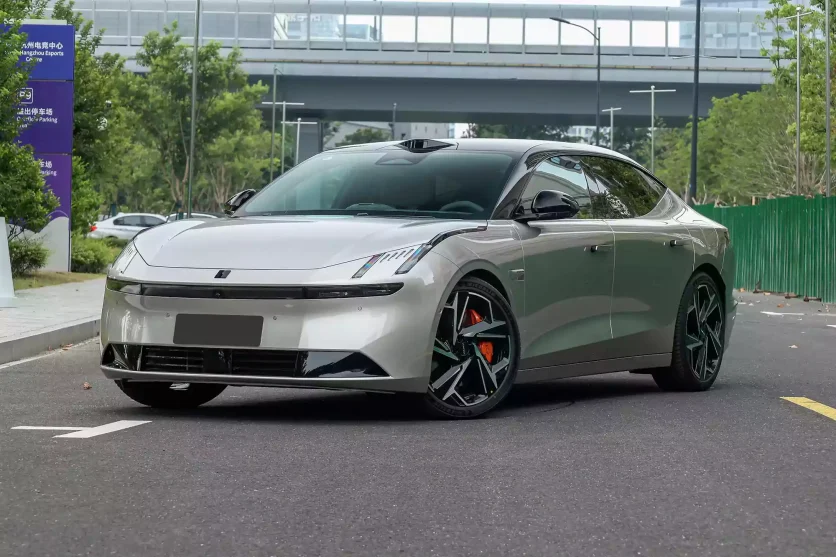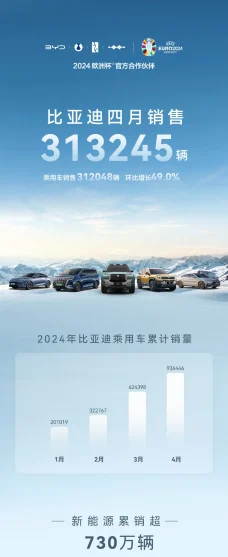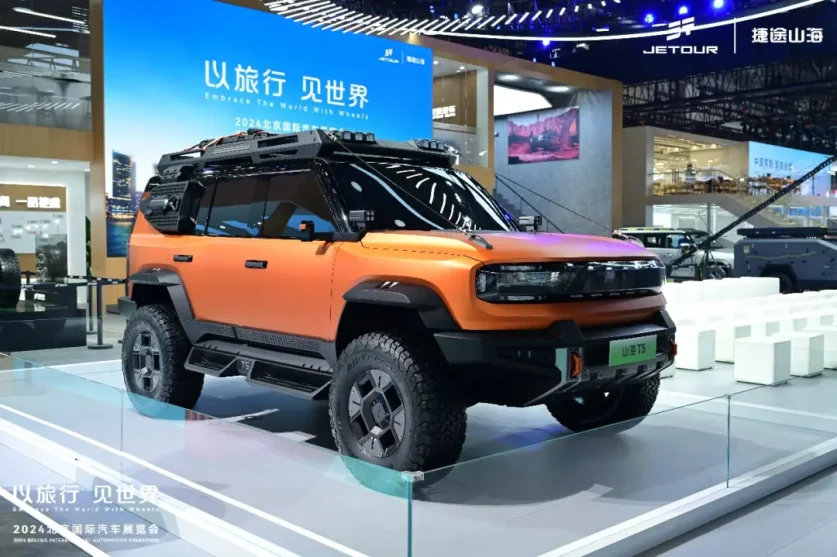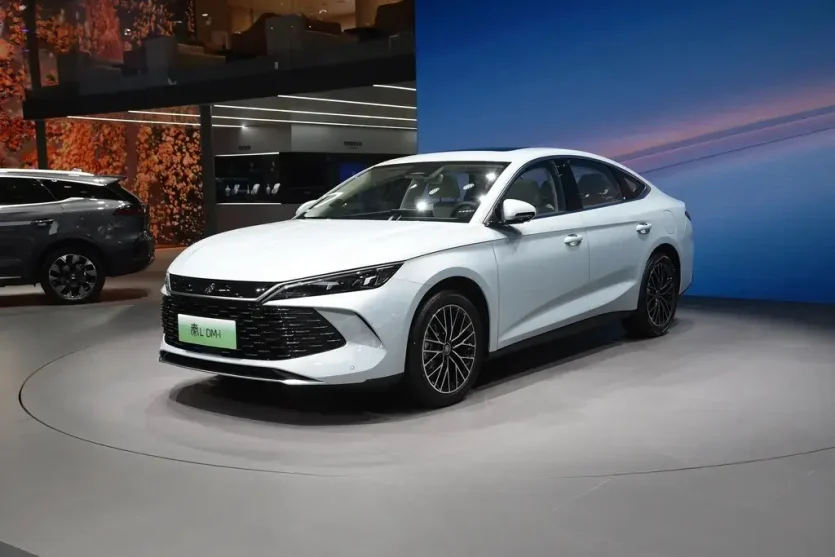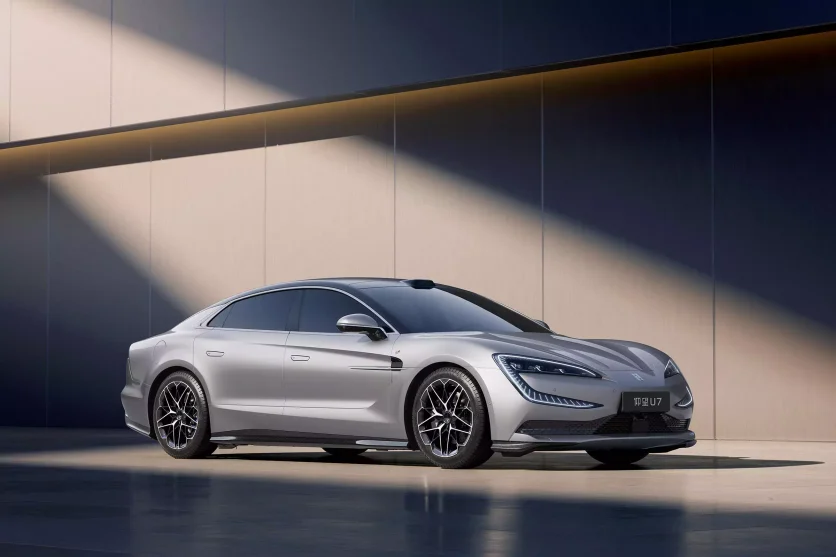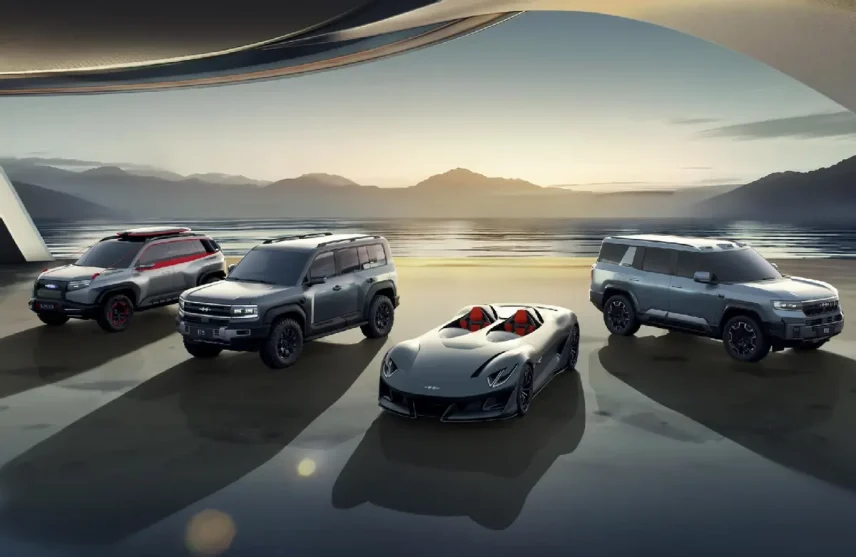Top 5 Chinese Electric Cars Set to Launch in 2025
In 2025 China is set to remain the world’s largest car exporter. A big portion of these exports will likely come from the new energy vehicles set to come out of China this year. As we keep our fingers crossed, check out these top 5 Chinese electric cars set to launch in 2025!
If you’re curious about the next wave of automotive advancements, these models are worth keeping an eye on. So, without any further ado, let’s get started!
1. BYD Electric Sports Car
As EV enthusiasts eagerly await the arrival of the Tesla Roadster, BYD’s electric sports car might hit the ground soon. Inspired by the Fang Cheng Bao Super 9 concept, this EV is poised to challenge the likes of Porsche 911. There are rumors that this yet-to-be-named electric sports car will be launched under BYD’s luxury sub-brand Denza.
As per initial reports, the BYD electric sports car will feature a powertrain similar to the Denza Z9 GT. If that’s true, you’re looking at a tri-motor setup churning out around 1,000 horsepower. With such a powerful setup, you can also expect rapid acceleration. This electric sports car will surely give existing sports cars on the market a run for their money.
So, while Tesla Roadster is still awaiting its launch, this powerful e-sports car from China will arrive at the party. And no, we don’t think you’ll have to pay over $250,000 for this futuristic EV. In fact, BYD plans on keeping the prices much lower and competitive.

2. Xiaomi YU7
The tech-giant Xiaomi ventured into the EV space with its offering the SU7 sedan last year. However, this year it is looking to deliver a knockout punch with an all-electric SUV, the YU7. Where other ESUVs struggle to deliver a range of 500 km, YU7 might breach the 600 km mark. As we have heard, Xiaomi YU7 will have an all-electric range of up to 643 km on a single charge.
Featuring a dual-motor setup, Xiaomi YU7 will deliver approximately 681 hp to the wheel. Acceleration will be great as usual with an expected top speed of up to 253 km/h. With advanced autonomous driving capabilities and a state-of-the-art infotainment system, the YU7 is set to redefine the smart EV experience.
We expect the interior to feature a minimalist design with a focus on premium materials and a massive central display. It might be the “smartphone on the wheels” we have been promised for years. YU7’s hyper-OS powered ecosystem will likely blur the lines between smartphone and car. Everything combined, the Xiaomi YU7 is set to be a top contender in the mid-range EV market.

3. Avatr 06
Avatr, a collaboration between Changan, Huawei, and CATL, has already created a buzz with its previous models. However, the futuristic EV brand will up the ante this time with a premium mid-size sedan in Avatr 06. After its debut in China, Avatr 06 will hit the overseas markets such as the UAE soon. The 06 promises a blend of cutting-edge tech and stylish design.
It is expected to feature Huawei’s advanced DriveOne powertrain. This powertrain will be paired with CATL’s high-density batteries of up to 82 kWh. As per original plans, Avatr 06 will be launched with two different powertrains. An extended range electric vehicle (EREV) or a pure EV. The EREV will be laced with a smaller battery pack of 39 kWh for extended range.
Similarly, the drivetrain will also offer versatility. You would be able to choose between a single-motor rear-wheel drive variant or a dual-motor all-wheel drive version. Range for the all-electric option is expected to be up to 650 km. Whereas the EREV options will take it a notch higher to 1,050 km. In short, Avatr 06 is poised to deliver a premium electric mobility experience.

4. NIO ET9
This year NIO is preparing to expand its lineup with the highly anticipated NIO ET9. This flagship electric crossover SUV is set to challenge luxury EVs in both performance and innovation. Initial reports suggest NIO ET9 will feature the latest 120 kWh solid-state battery. This large-sized battery pack will offer a staggering range of over 650 km.
NIO ET9 will likely bring the concerns like range anxiety down with its range and 900V fast charging architecture. For the first time, an EV will be able to charge its batteries at speeds of over 600 kW. It will ensure you never run out of our juice on long journeys. Even if you do, you can get back on the road as early as you drink a cup of coffee.
NIO’s hallmark features like battery swapping and advanced autonomous driving capabilities will undoubtedly be part of the package. The interior will also emphasize futuristic design with premium materials and customizable ambient lighting for an ultra-luxurious experience. NIO ET9 could very well steal the spotlight as one of the most advanced electric SUVs on the market.

5. Zeekr 007 Touring(007 GT)
Geely’s premium EV brand Zeekr is gearing up to launch its latest masterpiece, the Zeekr 007 Touring. This EV aims to blend performance with long-distance comfort. The 007 Touring is designed to appeal to families and performance enthusiasts alike. With its spacious interiors, premium materials, and advanced tech features, 007 is definitely worth the wait.
Built on Geely’s SEA platform, this sleek EV is expected to offer versatility in powertrains as well. It will be launched in single-motor RWD and dual-motor AWD variants. With an expected battery size of over 100 kWh, Zeekr 007 touring will surpass the 850 km mark.
Advanced driver-assistance systems will also be standard, ensuring safety and convenience on every journey. Additionally, Zeekr’s focus on affordability and innovation could make 007 a strong contender in the safe family EV segment.

Final Word: Best Chinese Electric Cars Launching in 2025
So, there you have it. The top 5 Chinese electric cars launching in 2025. These models are set to turn the future of electric mobility even brighter. As top Chinese brands focus on quality and innovation, you should keep an eye on the next wave of cutting-edge EVs.
Are you looking to buy a latest electric car from China at affordable prices? We can help! GuangcaiAuto is your partner in importing the latest Chinese electric cars. With a selection of 60+ worldwide EV brands and efficient, cost-effective shipping, we make the process seamless.
Let us handle the complexities while you enjoy the benefits of a cutting-edge Chinese EV. Contact our sales team, explore your options, and let’s embark on this exciting journey together.
Keep following our blogs for more information on the latest electric cars launching in China!
Both SUV And Pickup Truck, Changan Qiyuan E07
In August, Changan Qiyuan sold 12,823 units, and in order to realize further, Changan Qiyuan E07 came to help. Although the new car is positioned as a medium-sized SUV, it can also be transformed into a pickup truck, and has the handling and comfort of a sedan, which can be said to be one car against many.
This car in the form of power to provide extended range version and pure electric version optional. And it is equipped with 800V high-voltage fast charging, air suspension + CDC, Changan Smart Driving (dual LIDAR), etc. It is expected to start selling at 300,000 yuan.
A few days ago, the actual car of Changan Qiyuan E07 has arrived at the store, which means that it is not far from the listing.
*Changan Qiyuan E07 is the transliteration of the Chinese name (长安启源E07). In other countries, Changan Qiyuan E07 is also known as Changan NEVO E07.


Front of Changan Qiyuan E07
From the actual car picture, Changan Qiyuan E07 will adopt a rather sci-fi and avant-garde design style. The square and hard closed head is equipped with a piece of customizable content “display”. And the “display” and the two sides of the “C” shaped headlight group connected to form a through style, creating a full of technology.
The lower grille is different for the range extender and electric version. Qiyuan E07 will be equipped with Changan’s self-developed L2+ level intelligent driving pilot assisted driving system, which can realize functions such as autonomous on- and off-ramp, autonomous lane changing and overtaking.

Qiyuan E07 From Side View
The body dimensions are 5045/1996/1695 (1640, 1665) mm, with a wheelbase of 3120 mm. Changan Qiyuan E07’s huge body with full lines outlined, as well as expanding smoked wheelbrow, giving people the feeling of muscle power.
The roofline transitions smoothly from the front to the back, and with the roof rack, it is quite a crossover SUV style.
In addition, the addition of 21-inch two-tone semi-closed wheels, hidden door handles, and ring-through taillights continue to emphasize the fashion-forward attributes, and a total of seven vehicle colors, including frosted paint, are available.


Transformable Changan Qiyuan E07
The biggest highlight of Changan Qiyuan E07 is the transformable trunk. Its tailgate can be divided into two parts.
The upper part can be opened electrically like a sunroof. The lower part is a flip-down design, and when fully opened, it is a pickup truck that can be transformed into a station wagon, a camper, a fishing machine, and so on, according to the user’s needs.
In addition, when the rear seats are put down flat, it can also expand a larger practical space and provide a front trunk.



Interior of Changan Qiyuan E07
The interior of the Changan Qiyuan E07 continues the family design language. The simple center console is equipped with a 15.4-inch “sunflower” screen and HUD head-up display instead of the traditional instrument panel, as well as a new three-spoke steering wheel + electronic gearshift.
In addition, the front row is equipped with zero-gravity seats with electric legrests. And support ventilation/heating/massage functions, plus the passenger visor entertainment screen, enjoy the “queen” treatment.
The 18 stereo surround speakers, 256-color ambient lighting, scent system, and rear 3D-PAD further enhance the ride comfort.


Power System
According to the previous declaration information, the Changan Qiyuan E07 range-extended version is equipped with a 1.5T range-extended system, and offers rear-wheel drive and four-wheel drive versions as options.
The rear-wheel drive version is equipped with a 231kW drive motor, and the four-wheel drive version is equipped with 131kW+231kW dual motors. The battery pack capacity is 39.05kWh, and the pure electric range is 185km and 200km respectively.
The pure electric version is also available in rear-wheel drive and four-wheel drive.
The rear-wheel drive version offers 165kW and 252kW drive motors. The four-wheel drive version is equipped with 188kW+252kW dual motors.
The system has a combined power of 440kW (598hp), a 100km acceleration of 4 seconds, and supports 800V high-voltage fast charging, which can achieve a 365km range in about 15 minutes of charging.

Other Aspects
Changan Qiyuan E07 will also be equipped with front double-wishbone + rear H-arm all-aluminum independent suspension. And equipped with intelligent magic carpet suspension technology, the air suspension can realize the height of 90mm adjustable and soft and hard infinitely adjustable.
This allows Qiyuan E07 to adapt to various road conditions and driving style preferences. Of course, information about the new car is still to be officially announced further. We’ll keep an eye out for updates.
Hyundai Santa Fe Goes On Sale In China
Right now, the 2024 Chengdu International Auto Show is in full swing, many new cars have chosen to make their public debut at the show. Beijing Hyundai Santa Fe series is one of them.
The auto show debut and the listing work is completed simultaneously, the new car is equipped with 2.0T + 8AT, the value of the face is renewed, the interior and configuration is upgraded, MSRP: 195,800 yuan – 268,800 yuan.
What are the other highlights of the fifth generation Santa Fe? Take a look together.

Exterior of Hyundai Santa Fe
The styling of the fifth-generation Santa Fe bears some traces of softening, but the main module is still dominated by a hardcore, chunky and composed style. Layered transformations and component contours also appear to be distinctly hardened and even somewhat similar to some off-road models.
The H-shaped LED light clusters are integrated with the smoked upper grille, while the combination of the lower grille and the shell also appears to be H-shaped. The new Santa Fe is a real cosmetic change, and it’s a good way to see how seriously the Hyundai brand has taken the new model.

Side And Rear of the Car
Hyundai Santa Fe has a square side shape, with a hidden rock climbing handle as a highlight, with a maximum load capacity of 200KG. The changes in the rear image design are also distinctive, with the sunken H-shaped taillight design being the most central key.
However, the external changes only enhance the personalization elements, and the overall design still focuses on the city car style, with a better balance of applied elements. There is also a single decorative exhaust pipe at the bottom side to enhance the dynamic effect, and even the preferences of the young audience are also satisfied.

Interior of Hyundai Santa Fe
The interior design of Hyundai Santa Fe is based on the framework of mainstream symmetrical layout. Starting from the gear lever control area, the knob-type pocket gear design omits more physical space for hardware and matches the multi-function steering wheel made of leather for better driving and control feel.
Maximum 12.3-inch full LCD instrumentation and 12.3-inch center control screen with dual-screen parallel design, compression of space occupation ratio, and creates a more intense technological atmosphere.

Safety features
In terms of safety, the fifth-generation Santa Fe supports lane departure warning, forward traffic crossing warning, lane centering keeping, active braking and other functions. And there is also a sizable intelligence enhancement operation in the car assistance, L2 level assisted driving becomes the series standard content, and accompanied by the front vehicle drive away reminder, full-speed adaptive cruise control together.
The mid-range models are equipped with automatic lane-change assist design, which provides better convenience and intuitively reduces the difficulty of driving control in large-sized models.

Seats in Hyundai Santa Fe
The seats are covered with faux leather and the built-in padding is thick enough. Together with the raised structure design of the outer rim contour, you can enjoy a full sense of invisibility when sitting in them.
Higher-end models also changed to Nappa leather style design, in the visual effect and tactile feel gives a better sense of class performance, for different levels of demand to give better satisfaction.

Dimensions of the Space
The Hyundai Santa Fe measures 4830mm in length, 1900mm in width, and comes in 1770mm and 1780mm height sizes, all with a wheelbase of 2815mm.
Although positioned as a mid-sized SUV, the rear cabin space is significantly improved, in addition to the 2+3 large five-seat, but also provides 2+3+2 seven-seat option and 2+2+2 large six-seat standard, the space layout is flexible, to meet the needs of different family use.
In terms of space expansion alone, Santa Fe is comparable to a regular medium-sized family SUV.

The Santa Fe’s Power
Powering the Santa Fe’s G4NN model engine matches the off-road inclination of the exterior, with a 2.0T four-cylinder with 247Ps of horsepower, which works with the 8AT transmission to drive the vehicle together.
The different models have slight variations in the form of drive, which are categorized into two different forms: front-wheel drive and front-four-wheel drive.
One of the four-wheel drive models are also matched with a timely four-wheel drive and multi-plate clutch center differential, driving in urban environments there is also the effect of reducing energy consumption.

Summary
Taken together, the design of Hyundai’s fifth-generation Santa Fe does appear to have a number of highlights, and the overall suitability of the vehicle has been significantly improved. For enthusiastic self-driving travel enthusiasts, there is no doubt that it will become a good choice.
Of course, the urban environment is equally suitable for application, plus 92 gasoline, choose the fifth generation Santa Fe as a family car is also very suitable.
Lynk & Co Z10 is Finally on The Market
It is estimated that Lynk & Co fans now have a feeling of “waiting for a long time and finally waiting for today”, yes, in the evening of September 5, Lynk & Co’s first pure electric car model – Lynk & Co Z10 officially launched.
Why Long-awaited?
In fact, Lynk & Co has been preparing for a pure electric car model a long time ago, the most direct evidence is the prototype of Lynk & Co Z10, Lynk & Co ZERO has been unveiled four years ago, as the first Geely Vast Architecture, Lynk & Co ZERO was unveiled, it was amazing.
But then due to well known reasons, the production car Lynk & Co Z10 was late for four years, and the four-year period, the Chinese automobile market has changed dramatically.
The Chinese auto market has undergone radical changes, it can be said that the lack of pure electric models Lynk & Co, the development of these four years is subject to a lot of constraints.
Therefore, manufacturers, dealers and fans of Lynk & Co users have the feeling of “waiting for a long time and finally waiting for today”.

Lynk & Co Z10 Exterior Design
Lynk & Co Z10 is really not bad, after four years, not only give a very competitive price, but also inherited the original Lynk & Co ZERO prototype design to bring a sense of surprise, the whole has a strong mecha style, quite a sense of the future of the immediate sense of the chariot.
There is a sentence to say may be a little offended, but I still can not help but say: Lynk & Co Z10 styling design is obviously more than Xiaomi SU7 to be more attentive, regardless of the originality of the design, the exploration of the direction of the new era of automotive design, the Lynk & Co Z10 undoubtedly stepped out of the farther step.

Lynk & Co Z10 Dimensions
In body size, Lynk & Co Z10 body length also exceeded 5 meters, specific length, width and height of 5028/1966/1468mm, wheelbase of 3005mm, this size can be referred to the current street are running Audi A6L.
Yes, due to the design of the more focus on the effect of the low slump, so in the photo looks Lynk & Co Z10 is not big.
But the actual length of more than 5 meters, enough to prove that the car is a good choice. It’s a no-brainer that this is a big guy, but what’s even more remarkable is that the Lynk & Co Z10’s wind resistance factor is just 0.198Cd, a very impressive figure.

Z10 Interior
The interior design is dominated by a 15.4-inch center control screen, and the whole is still the usual minimalist style of new energy vehicles.
But the Lynk & Co Z10 also hides some small designs, such as the 12.3:1 narrow strip of the full LCD instrument panel, as well as a light strip that runs almost through the center console.
So, it can be said that in the pursuit of conforming to the aesthetics of all people, but also hides some of their own small thoughts.

Comfort Features
In terms of comfort features, the Lynk & Co Z10 also does a good job, such as the extensive use of leather and suede materials throughout the car, rear seats with ventilation/heating/massage function, audio is also equipped with Harman Kardon audio and WANOS panoramic sound technology (7.1.4 channels, 23 speakers, 1600W amplifier).
In short, as the Lynk & Co brand’s first electric car, through these big cost of stacking materials. You can indeed see that Lynk & Co is holding its breath to play the return of the king.

Other Configuration
The Lynk & Co Z10 shares a platform with the ZEEKR 001, offers 400V and 800V models, accelerates from 0-100km/h in 3.5 seconds, and has a range of more than 800km with a 15-minute charge that can be replenished to 573km.
Smart Driving is equipped with NVIDIA Orin-X chip with LiDAR, which can realize high-speed NOA and urban NOA without map.
Lynk & Co Z10 Prospects
In fact, the 200,000 level of pure electric cars, is still full of competition, Xiaomi SU7, ZEEKR 001/007, Rising Auto F7, IM L6, Tesla Model 3, etc., each has a good competitiveness. So, the pressure Lynk & Co Z10 to face is actually not small.
And in addition to adhere to create high-quality products, stacking stronger competitiveness of this approach, Lynk & Co also has the advantage of more than 1.17 million users, has a very good market reputation. Coupled with Lynk’s users have always been brand loyalty is very high, which behind more than 1 million user base of Lynk. These will become one of the major growth points of Lynk & Co Z10.
Top 10 sales of electric cars in China in April 2024
Time flies, April 2024 has passed. Let us review the sales performance of various Chinese automobile manufacturers in April.

The above are the top 21 brands in China in terms of sales in April. Please see below for more detailed data.
BYD
BYD‘s passenger car sales in April reached 313,245 units, with BYD Auto (Dynasty Network + Ocean Network) accounting for 297,864 units, Denza car sales totaling 11,122 units, Yangwang car sales reaching 952 units, and Fangchengbao car sales amounting to 2,110 units.

During BYD’s 2023 annual financial report communication meeting, Wang Chuanfu mentioned that BYD’s sales target for 2024 is to grow by over 20% compared to 2023, reaching 3.6 million units. Currently, BYD’s total sales for 2024 have already exceeded 930,000 units. Even if we calculate sales at 300,000 units per month for the remaining months, achieving the 3.6 million sales target doesn’t seem too difficult – as long as they can sell over 30,000 more vehicles each month for the next 8 months. Whether or not this scenario will unfold depends on BYD’s actions moving forward.
Geely
Geely Auto sold a total of 51,428 new energy vehicles in April. Among them, Lynk & Co delivered 16,089 units, Geely Galaxy delivered 12,725 units, and Geometry delivered 12,630 units.

Geely, adhering to its “multi-brand strategy,” has truly achieved a diversified approach in the field of new energy vehicles. With the high-end pure electric brand ZEEKR, and the more mainstream Geely Galaxy and Geely Geometry, Geely is effectively implementing a multi-faceted approach. Additionally, Lynk & Co has made strides in the new energy transition with its EM-P models, with pre-sale orders for the Lynk & Co 07 EM-P surpassing 10,000 units. With the introduction of more Geely-affiliated products into the market, Geely’s presence in the new energy market is likely to continue to grow.
Chery
In April, Chery Group sold 32,995 new energy vehicles, with the iCAR brand accounting for 7,524 units of that total.

Entering 2024, Chery Automobile has clearly begun to make strides in the field of new energy vehicles, with products in various power forms including hybrid and pure electric being strategically positioned. Their iCAR brand, targeting trendy young consumers, has seen promising performance, with their first model, the iCAR 03, achieving over ten thousand units in cumulative sales within just two months of its launch. Additionally, Chery Group has several heavyweight products poised for release, including the Chery Fengyun T9, EXEED Star of the Era ET, and Jetour Shanhai T2, all awaiting their debut. With Chery’s entry into the competition, the future of the domestic new energy vehicle market is undoubtedly set to become more vibrant.
Huawei series car brands
In April, HarmonyOS-enabled HiCar delivered 29,632 units.

While Huawei doesn’t manufacture cars, its HarmonyOS-enabled HiCar has already shown remarkable results in empowering automakers. Additionally, the officially mentioned “repeated monthly sales champion among Chinese new energy brands” statistics also encompass data from both the AITO and Luxeed brands.
In detail, in April, AITO M9 delivered 13,391 units, AITO New M7 delivered 10,896 units, Luxeed S7 delivered 4,546 units, and the remaining were likely AITO M5. Among them, Luxeed S7, after overcoming some difficulties, began to see an increase in deliveries, while the delivery volume of AITO M9, surpassing ten thousand units and even higher than AITO New M7, was surprising. Furthermore, there are the recently launched AITO New M5 and the soon-to-be-launched STELATO S9. Undoubtedly, with the increasingly diverse product offerings of HarmonyOS-enabled HiCar, it has gradually become a force to be reckoned with in the automotive industry.
GAC Aion
GAC Aion sold 28,113 units in April.

Compared to the previous trend of monthly sales surpassing 40,000 units and catching up to 50,000 units, GAC Aion’s recent sales figures appear less than ideal. While still maintaining a considerable customer base, the increasingly complex market environment poses challenges even for leading players in the new energy sector. It seems that even the top players in the new energy sector are finding it difficult to remain stable amidst the evolving market conditions, requiring everyone to adapt and innovate.
Li Auto
Li Auto delivered 25,787 vehicles in April.

Although Li Auto’s recent delivery performance hasn’t been ideal, the official response has been swift. In April, Li Auto not only adjusted prices across its entire product lineup but also introduced the new model Li Auto L6. When the next sales report is released, we believe Li Auto’s delivery performance will show a significant improvement.
ZEEKR
ZEEKR delivered 16,089 vehicles in April.

In April, ZEEKR saw a significant increase in delivery volume, reaching a historic high. It seems that Xiaomi’s high-profile entry may have spurred hesitant users to make purchasing decisions after comparing with the Xiaomi SU7. However, it’s the product strength showcased by the all-new ZEEKR 001 that ultimately wins over users.
NIO
NIO delivered 15,620 vehicles in April.

Recently, NIO, which has frequently secured cooperation with peer companies in the field of energy supplementation, has shown a steady upward trend in sales. Clearly, even now, NIO, with its battery swap model as a brand moat, remains an irreplaceable part of the market. Furthermore, NIO’s lower-priced sub-brand, ONVO, is also set to meet users soon. With ONVO cars that can achieve higher sales volume, I believe NIO’s overall sales and business performance will be enhanced.
Leapmotor
Leapmotor delivered 15,005 vehicles in April.
In April, Leapmotor’s two SUV models, the Leapmotor C11 and Leapmotor C10, together exceeded ten thousand deliveries. Leapmotor, which once gained recognition with its pure electric mini car, the Leapmotor T03, ultimately succeeded in product upgrades, using higher-priced products to drive the majority of sales and revenue. In addition, Leapmotor also launched a larger vehicle (officially defined as MPSUV), the Leapmotor C16, with progress in overseas markets steadily advancing through cooperation with the Stellantis Group. It is evident that Leapmotor is making significant strides forward.
Changan DEEPAL
DEEPAL delivered 12,744 vehicles in April.
Thanks to the Deepal SL03 and Deepal S7, as well as positive market responses, Deepal Motors has consistently maintained stable delivery performance. Next up, the highly anticipated Deepal G318 is finally nearing its release. New energy hardcore off-roading has been a recent focus in the industry, and with the addition of electric motors, fuel consumption and comfort have both seen significant improvements. With the Deepal G318, I believe Deepal Motors’ delivery volume will reach new heights.
Changan Qiyuan
Changan Qiyuan delivered 11,833 vehicles in April.
Although Changan Qiyuan may not have a large presence on the internet, its actual monthly sales have already surpassed ten thousand. On one hand, this is because entry-level family cars represent the largest segment in terms of scale, and as long as the product is competitive, consumers will naturally vote with their wallets. On the other hand, it’s also because Changan’s channel advantages are quite significant, and offline transactions are also a force to be reckoned with.
SAIC Volkswagen New Energy
SAIC Volkswagen New Energy achieved sales of over ten thousand units in April.

This sales figure of over ten thousand units likely includes not only the ID. family but also the Passat PHEV and Tiguan L PHEV, two plug-in hybrid models outside of the pure electric lineup. However, with Shanghai no longer providing free use of small car quotas for plug-in hybrid models, overall, the ID. family still contributed the majority of SAIC Volkswagen New Energy’s sales volume. As for why they’re grouped together this time, it’s probably to make the data look more appealing.
Xpeng
Xpeng Motors delivered 9,393 vehicles in April.

Although the delivery volume of the Xpeng X9 is commendable, with nearly 10,000 units delivered in the first four months after its launch, MPVs, being a relatively niche vehicle type, cannot solely support Xpeng’s overall delivery volume. As the more versatile Xpeng G6 gradually catches up with competitors in terms of technology, how to further increase delivery volume remains a challenge that XPeng needs to address.
Neta
The Neta delivered 9,017 vehicles in April.

Neta, once the top seller among domestic new energy vehicles, has gradually found a new rhythm. In the Southeast Asian market, Neta is steadily expanding its presence, while domestically, the new model Neta L was launched in April and has already secured over 15,000 orders. Judging from the monthly delivery figures, Neta has maintained its stance and is gradually adapting to new changes.
SAIC-GM
SAIC-GM delivered a total of 8,762 new energy vehicles across its three brands in April.

SAIC-GM’s delivery of 8,762 vehicles was contributed by the Buick, Cadillac, and Chevrolet brands. Among them, the Buick Velite 6 has consecutively topped the sales charts for eight weeks in the joint venture’s new energy segment, making it likely the best-selling new energy vehicle among the three brands mentioned. Looking ahead, SAIC-GM will introduce three heavyweight new energy models: the plug-in hybrid version of the Buick GL8, the pure electric Cadillac Lyriq, and the plug-in hybrid SUV Chevrolet Explorer Plus. These releases may have the potential to challenge Volkswagen’s position as the leader in joint venture new energy vehicles.
Xiaomi
Xiaomi delivered 7,058 units of the SU7 in April.

The Xiaomi SU7, launched on March 28th, began its first deliveries on April 3rd. Therefore, the 7,058 units delivered in April represent a partial month’s data, showcasing its impressive appeal. As Xiaomi’s automotive production capacity and delivery capabilities continue to improve gradually, we anticipate even higher delivery numbers in May.
Avatr
Avatr delivered 5,247 vehicles in April.

In the face of the aggressive Xiaomi SU7, Avatr decisively responded with the 2024 Avatr 12. Not only did the new car undergo upgrades, but its starting price also dropped by 35,000 yuan. After this wave of offense and defense, Avatr firmly held its ground. Subsequent continuous upgrades in intelligent cockpit and driving functions will help Avatr maintain its competitiveness. The upcoming “battle” is expected to be even more exciting.
Voyah
Voyah delivered 4,003 vehicles in April.

Since the beginning of 2024, Voyah’s delivery performance has shown a significant improvement compared to last year, although the growth momentum seems to have slowed down. To address this, Voyah has adopted several strategies. First, it has initiated comprehensive cooperation with Huawei in the fields of intelligent cockpit and autonomous driving. Second, it is preparing to launch a new pure electric SUV tailored for families. Third, it plans to provide more advanced tri-electric technologies such as universal 800V, 5C ultra-fast charging, and 1000kW charging piles. It remains to be seen what surprises will come next.
Jetour 2024 Beijing Auto Show
On April 25th, 2024, the 18th Beijing International Automotive Exhibition officially kicked off, attracting numerous domestic and international automotive companies. During this event, Chinese domestic brands, joint ventures, and overseas automakers showcased their flagship models or unveiled new concept cars, demonstrating their respective strengths and prowess to the world.

During the Beijing Auto Show, Jetour presented a lineup of heavyweight models, primarily from the Jetour Shanhai new energy series. This lineup included the recently launched Jetour Shanhai T2, as well as the upcoming Jetour Shanhai T1, Jetour Shanhai T5, Jetour Shanhai L6, and Jetour Shanhai L7. Additionally, Jetour showcased the extended seven-seater version of the Jetour Traveler, the Jetour JMK- and Peace Elite collaboration model, and Jetour’s first officially certified production travel camping trailer, the “Travel BOX.”
Jetour Shanhai T2
The Jetour Shanhai T2 is positioned as a compact travel off-road SUV, available in three models with prices ranging from 179,900 to 209,900 RMB. According to Chezhe, the Jetour Shanhai T2 is equipped with the Kunpeng Super Hybrid C-DM powertrain system, comprising a 1.5-liter turbocharged engine and an electric motor in a plug-in hybrid setup. The engine delivers a maximum power of 115 kW and a maximum torque of 220 N·m, while the electric motor provides a maximum power of 165 kW and a maximum torque of 390 N·m.




In terms of transmission, the Jetour Shanhai T2 is equipped with a 3DHT hybrid-specific transmission. Regarding the battery and range, depending on the configuration, the Jetour Shanhai T2 comes with either a 26.7 kWh or a 43.24 kWh lithium iron phosphate battery. Under CLTC conditions, the pure electric range is 129 km and 208 km respectively. With a full tank of gas and fully charged battery, the top-of-the-line model of the Jetour Shanhai T2 can achieve a range of over 1300 km under CLTC conditions.
Jetour Shanhai T1
Also present at the auto show was the Jetour Shanhai T1. Positioned as a comfortable and rugged SUV, the exterior design of this model exudes a tough and adventurous vibe. According to official sources, Jetour will offer a wide range of body color options and versatile customization options for the Jetour Shanhai T1, catering to the diverse and personalized preferences of consumers.




Jetour Shanhai T5
In addition, the more upscale Jetour Shanhai T5 made its official debut. According to Chezhe, the Jetour Shanhai T5 is positioned as a fully intelligent off-road hybrid SUV for all scenarios and is Jetour’s first off-road model with a crossbeam. In terms of power performance, the Jetour Shanhai T5 will be the first to be equipped with a plug-in hybrid powertrain system consisting of a 2.0TGDI longitudinal hybrid engine and front and rear dual motors. When combined with the “three-lock” system, the new vehicle’s off-road capabilities will be exceptionally formidable.



Jetour Shanhai L series
In addition to the rugged off-road-oriented Jetour Shanhai T series, Jetour also introduced the family travel-oriented Jetour Shanhai L6 and Jetour Shanhai L7. According to reports, these two new models will be equipped with the Kunpeng Super Hybrid C-DM powertrain system. Specifically, the Jetour Shanhai L7 is positioned as a seven-seater hybrid SUV suitable for families, while the Jetour Shanhai L6 is positioned as a stylishly designed five-seater SUV.







The future of Jetour brand
Since its establishment in 2018, Jetour has swiftly emerged as a dark horse in the Chinese automotive market, leveraging its unique positioning of “travel+” along with advantages such as spacious interiors and high cost-effectiveness. By the end of 2023, Jetour achieved its milestone of selling over 1 million vehicles in just 65 months. Throughout the entirety of 2023, Jetour’s sales surged to between 300,000 and 315,000 vehicles, marking a remarkable 75% increase compared to the same period in 2022.
Facing the fiercely competitive landscape of 2024, Jetour continues to maintain its status as a dark horse, achieving significant growth. According to Dai Lihong, Assistant General Manager of Chery Automobile Co., Ltd. and Executive Vice General Manager of Jetour Brand Division, Jetour is expected to achieve cumulative sales of over 140,000 vehicles in the first four months of 2024, representing a year-on-year growth of 101%. Building on a foundation of cumulative sales exceeding 1.1 million vehicles, Jetour aims to achieve an annual sales target of 1 million vehicles by 2026. To achieve this goal, Jetour plans to introduce a series of new models over the next two years, covering a wide range of scenarios from family travel to off-road adventures.
BYD’s 9 new cars at the Beijing Auto Show
BYD should be the brand with the most new car debuts at the Beijing Auto Show, unveiling a total of 9 new models. Prices range from hundreds of thousands to millions of RMB. Let’s take a look together – which one do you think you would prefer?
BYD Qin L DM-i
The BYD Dynasty series features the BYD Qin L, which is equipped with BYD’s fifth-generation super hybrid DM-i technology. It comes in two versions: one with a pure electric range of 60 kilometers and another with a range of 90 kilometers. With a length of 4.83 meters and a fuel consumption of only 3.8 liters per hundred kilometers, this size and fuel efficiency might indeed pose significant competition to models like the Volkswagen Sagitar and Honda Civic.

There are two opinions regarding the appearance of this car. One suggests that it’s an extended version of the BYD Qin PLUS, while the other suggests it’s a downsized version of the BYD Han. Based on the design of the front face and taillights, I’m inclined to lean towards the notion of it being a downsized version of the BYD Han. What do you think?

BYD Sea Liong 07
The second model is the Ocean series’ Sea Lion 07, an all-electric SUV. It shares similar dimensions and wheelbase with the Dynasty series’ BYD Song L, making them sister models. However, their appearances are entirely different. The Sea Lion 07’s front face and rear end resemble an enlarged version of a BYD Seal, don’t you think?

BYD Seal 06

The third model: BYD Seal 06. This car actually utilizes the same BYD fifth-generation super hybrid DM-i technology as the BYD Qin L. However, the Seal 06 is a downsized version of the BYD Seal DM-i in terms of appearance, with slight differences in the lower front bumper design.

BYD OCEAN-M
The fourth model: OCEAN-M. This is a vehicle from the Ocean series, with a possible price range of 150,000 to 200,000 RMB. Within the Ocean series, there are numerous overlapping models in this price range. I believe that to sell well, it needs to highlight its niche identity as a two-door steel cannon.

BYD Yangwang U7
The fifth model: BYD Yangwang booth, BYD Yangwang U7. Judging by the name, which one do you think is larger, the BYD Yangwang U7 or the BYD Yangwang U9? Actually, the U9 is a two-door supercar, while the U7 is a larger four-door coupe, similar to the feel of the Porsche Panamera.

Denza Z9GT
TDenza is an automotive brand under BYD. Denza was established in 2010 as a joint venture between BYD and Daimler, a product of the collaboration between BYD and Daimler’s Mercedes-Benz. Despite being a joint venture, the development of the Denza brand has not been particularly smooth. On December 25, 2021, BYD and Daimler signed an agreement to adjust the equity structure of their joint venture, Denza. The agreement aimed to transfer the equity of Denza between the two parties. After the transfer, BYD and Daimler would respectively hold 90% and 10% of the shares in Denza. Therefore, Denza naturally became a luxury brand under BYD.
The Denza Z9GT, where “Z” represents Denza’s sedan series, “9” denotes the flagship model, and “GT” leans towards sportiness and performance attributes. With its sleek coupe design, it’s quite handsome and aims to compete in the market against the Porsche Panamera.

Fangchengbao
The remaining three models are all showcased at the Fangchengbao booth. For more details, you can click on this blog post to learn more.



The above are the 9 new cars BYD launched at the Beijing Auto Show. Do you like any of them?
BYD Yangwang U7 is coming soon
After laying out the full-size SUV Yangwang U8 and the supercar Yangwang U9, BYD’s four-door coupe, the Yangwang U7, is also set to debut at the Beijing Auto Show. According to the manufacturer’s declaration, the Yangwang U7 is positioned as a large sedan, with dimensions of 5265/1998/1517mm (length/width/height) and a wheelbase of 3160mm, with a curb weight of 3095 kilograms.

Appearance
The BYD Yangwang U7 adopts the “Portal of Time” design concept, with unusually large C-shaped headlights that are not only very eye-catching but also give a sense of surrounding the front end. The grille and front bumper no longer have a sense of boundaries. Honestly, this front end gives a very luxurious feeling, and if it were to be damaged, the repair costs probably wouldn’t be low.


The side profile of the BYD Yangwang U7 is very dynamic, presenting a streamlined visual effect. The addition of a C-shaped waistline on the doors enhances the sense of layers and power of the body, while the side view of the headlights remains prominent. The roof features a smooth sloping design, with a slight angle between the A-pillar and the body, reducing the coefficient of drag to 0.195Cd to ensure its performance and range. The wheel options include 21-inch rims with a aspect ratio of 275/40.


The rear of the vehicle appears somewhat sturdy, with taillights featuring a two-segment through design, placing the Yangwang emblem at the center. However, compared to the front headlamps, the styling seems more conservative. The rear also includes a two-segment rear lip that echoes the taillights, enhancing the overall rear design.
BYD Yangwang U7 interior spy photos


The currently exposed interior features an orange-black color scheme. As a luxury sedan in the million RMB category, the materials used are undoubtedly high-quality, with large areas wrapped in leather. In terms of hardware, the Yangwang U7 provides three large screens in the front row, with the center console featuring an embedded large screen and no physical buttons below, replaced by touch controls.


The interior designs of the three Yangwang models have distinct differences, which can be easily distinguished by the steering wheel. The Yangwang U7 is equipped with a new D-shaped three-spoke steering wheel, which has a sporty appearance. Additionally, there are numerous shortcut buttons in the middle of the steering wheel, making it convenient for the driver to operate without looking.
Power
As a product of the e⁴ technology platform, the Yangwang U7 will also adopt four individual motors to drive each wheel separately. This will provide the vehicle with a maximum power exceeding 1000 horsepower, enabling the vehicle to accelerate from 0 to 100 km/h in less than 3 seconds. Additionally, it will support more robust power vector control. Despite its heavy weight of 3.095 tons, the Yangwang U7 still achieves an impressive top speed of up to 270 km/h.
The above is all the latest news about BYD Yangwang U7. Let’s look forward to its performance after it is officially launched.
China’s electric car sales are unstoppable
Recently, the China Passenger Car Association released a car market report, revealing the latest developments in the passenger vehicle market from April 7th to 14th. During this period, the performance of the electric car market was particularly remarkable, with both wholesale and retail penetration rates exceeding 50%. This data was also mentioned by BYD Chairman Wang Chuanfu at the China Electric Vehicle Hundred-Person Forum not long ago.

Specific data
According to the report, from April 1st to 14th, the retail sales volume of passenger vehicles in the market was 516,000 units, a decrease of 11% compared to the same period last year, and a slight decline compared to the same period last month. However, the cumulative retail sales volume for this year reached 5.348 million units, an increase of 10% compared to the same period last year. At the same time, the wholesale volume of passenger vehicles from manufacturers nationwide was 534,000 units, an increase of 13% year-on-year, but also a decrease compared to the same period last month.
In the electric car sector, data shows that from April 1st to 14th, the retail sales volume of electric cars reached 260,000 units, a remarkable increase of 32% compared to the same period last year, and also an increase compared to the same period last month. The cumulative retail sales volume for this year in the electric car sector has reached 2.032 million units, showing a staggering 34% year-on-year growth. Additionally, the wholesale volume of electric cars from manufacturers nationwide was 268,000 units, marking a substantial 43% year-on-year increase, and also an increase compared to the same period last month.
What does the data show?
Based on this data, we can see that the importance of electric cars in the market is increasing. During this period, electric cars accounted for approximately 50.39% of retail sales and an astonishing 50.19% of wholesale sales in the passenger vehicle market. The penetration rate of electric cars in the passenger car market is accelerating, and their market share is continuously increasing.
In the future, with the continuous improvement of electric car technology and the enhancement of supporting infrastructure, we have reason to believe that the market share of electric cars will continue to rise, making them a dominant force in the future automotive market. This undoubtedly will bring new opportunities and challenges to the entire automotive industry, and we look forward to further developments in this field.
Fangchengbao launched China’s first roofless electric sports car
With sales of 3,550 units in a month, these are the sales figures for the Fangchengbao Bao 5 in March of this year. Since its launch in November last year, nearly 20,000 units have been delivered. For a hardcore hybrid off-road vehicle in the 300,000 RMB price range, this is already considered a success.

At the recent “Fanghua” Fangchengbao Automotive Spring Launch Event, Fangchengbao once again unveiled two hardcore off-road vehicles, the Bao 8 and Bao 3 concept cars, along with the SUPER 9 concept sports car, expanding its product lineup to four models. In this way, the entire family of vehicles made its debut as a tribute to BYD‘s 30th anniversary.
Fangchengbao Bao 8
Among them, the Fangchengbao Bao 8 made its global debut at this conference, positioned as a mid-to-large-sized hardcore off-road vehicle. It evolved from the previously released concept car, the SUPER 8, and is currently Fangchengbao’s flagship model. Although the manufacturer has not fully disclosed the product information yet, it is known that the Bao 8’s body length exceeds 5 meters, and its wheelbase is also around 3 meters.

The Fangchengbao Bao 8 is built on the BYD DMO Super Hybrid Off-Road platform, with power reserves reportedly exceeding 500 kW and a combined fuel consumption of 7.8L/100 km. It also features the BYD DiSus-P hydraulic body control system and the CTC battery-chassis integration technology. CTC can be seen as an upgraded version of CTB, with the distinction being that CTB treats the entire battery pack as an independent unit, installed on the vehicle chassis, connecting the upper cover of the battery pack to the vehicle’s underbody, thus achieving an integrated structure of the battery and the body.

The CTC directly integrates the battery cells into the stamped and formed chassis floor, making the longitudinal and transverse beams of the vehicle body also serve as the battery cell housing, resulting in a more complete integrated structure. The CTC body integration technology can bring four significant improvements to the Fangchengbao Bao 8 — a more stable body structure, higher space utilization efficiency, increased safety, and improved handling!
Fangchengbao Bao 3
Next, let’s take a look at the Fangchengbao Bao 3. Although it appeared in the form of a concept car this time, as a member of the “583” product lineup, its mass production is already a certainty. Moreover, as a compact car, it enhances Fangchengbao’s product positioning. In terms of overall vehicle design, the Fangchengbao Bao 3 looks more like a scaled-down version of the Bao 5, with a square and rugged overall silhouette, and details that adopt the structure and design approach of an off-road vehicle.

Fangchengbao positions the Bao 3 as the “Trendy Play Expert.” From the concept car showcased, we can see attractive exterior elements such as expandable luggage space, roof spoilers, and carbon fiber trim. Additionally, according to information provided by the manufacturer, the Bao 3 will offer an interactive central control screen, a car-mounted drone similar to the Yangwang U8, and other features. Its power system will also be based on the DMO hybrid system. The Fangchengbao Bao 3 will emerge as a strong competitor to models like the Tank 300 and BJ40.
Fangchengbao brand

Many car enthusiasts perceive Fangchengbao as a competitor to brands like GWM Tank and Beijing Offroad, but this view is not entirely accurate. Strictly speaking, Fangchengbao is a “personalized” automotive brand rather than an off-road vehicle brand. At last year’s Fangchengbao brand conference, it was announced that the product lineup would cover three major segments: off-road vehicles, sports cars, and coupes, aiming to fully meet the diverse personal preferences of consumers.
Fangchengbao SUPER 9

The appearance of the SUPER 9 concept sports car is enough to illustrate this point. The design of the SUPER 9 has a futuristic feel, with the roof and front windshield removed, giving the entire body a sleek and dynamic look, presenting the posture expected of a supercar. While the overall design of the SUPER 9 is not suitable for mass production, many design details showcased for the first time, such as the lighting system, front bumper, and body air outlets, meet the standards for legal mass production. We can consider these design concepts as part of Fangchengbao’s sports car/coupe series.
Summary
With the unveiling of all four models, Fangchengbao’s planned “2+X” product system has taken its initial steps. The “2” refers to rugged SUVs and sports cars, while the “X” represents exploration of other automotive categories in collaboration with users to address more diverse consumer needs. The “X” can be seen as an exploration of unknown consumer demands.
This is not a short-term plan but rather a long-term strategy that requires continuous adjustment and improvement based on market and user insights. With this approach, Fangchengbao’s product development will have greater potential and flexibility, offering more possibilities and changes to anticipate.

